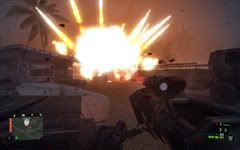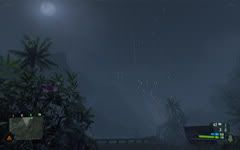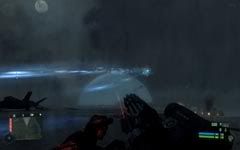
Crysis may not be a household name like Halo or Gears of War, but it's a name PC gamers fear. Some fear it out of reverence; others fear it because of its infamously high system requirements. The best approach, as long as you meet the minimum requirements to play the game acceptably (which is approximately a 2GHz dual-core processor and a $100 video card) is to take a look at TweakGuides' excellent document on how to fine-tune the game for your computer, figure out what works best, and then be content with it. Chances are you'll only lose super-high resolutions and a few neat light rays and stuff. Just pretend it's an Xbox 360 game. I say this because at maximum detail, it puts many Xbox 360 games to shame. It would also put many PS3 games to shame if there were such a thing as "many" PS3 games. Yet despite the game's seemingly excessive graphical aspirations, it's really amazing that it runs as well as it does. In fact, the few indoor portions of the game reveal just how efficient the engine is; they tend to run incredibly smoothly, even with complex polygonal humans walking about. The only part of the game that puts unreasonable demands on your PC is a certain ice/snow area that taxes the system far more than any other area does. I was able to resolve the situation by temporarily lowering my settings (namely, switching to DirectX 9 mode), but it's a bit of a quality-control blunder when what works for 98% of the game is suddenly insufficient for one part of it.
Anyway, on to the game! Crysis is from Crytek, the makers of Far Cry, the original CryEngine game. The only thing more impressive than Crytek's undying devotion to the word "cry" is their game design prowess. (Seriously though, what's the deal with the whole "Cry" thing? It's like some sort of alien attempt at a pun that's meant to hide a very unusual subliminal message.) Far Cry took the PC gaming world by surprise with its enormous tropical environments and generally excellent open-ended gameplay. It was a unique first-person shooter (and a very difficult one) where the player could navigate to his objectives via several different routes and methods.
Crysis -- which, confusingly enough, is NOT Far Cry 2, which is being developed by a different company -- builds upon and enhances this design. The biggest change is the inclusion of the Nanosuit, which both provides a feasible excuse for one-man-army-ism (how did Far Cry Guy manage to wield an entire vehicle-grade machine gun?) and lets the player choose from four modes: Cloak, Strength, Speed, and Armor. The most interesting mode here is Cloak because it makes stealth a more viable gameplay option, thus adding to the numerous strategies you can use. As with all of the modes, its effect wears off after about 5 seconds of full-blown usage, but that's enough to let you sneak around quite effectively without making the game too easy.
The other major difference between Far Cry and Crysis is the storyline. Far Cry was basically just the story of an extremely sarcastic man in a Hawaiian shirt going up against a mad scientist who spun the Wheel of Sci-Fi and landed on "Genetic Engineering" (instead of "Nanotechnology" or "Alien Invasion"). The gameplay was great, but the storytelling was about as engaging as that of Millipede. With Crysis, the developers have taken cues from games such as Halo and Half-Life 2 and improved the narrative quite a bit. That's not to say the story itself is incredible. The aforementioned Wheel of Sci-Fi has landed on "Alien Invasion" this time around (with a side of Nanotech, but just a little), and it's the standard pseudo-military tac-ops thing with a rag-tag gang of just-witty-enough-to-still-be-serious soldiers. But if I've learned one thing from Burger Time -- and trust me, I have learned many things from Burger Time -- a game's story is only as important as the gameplay it motivates. Perhaps a more relevant example would be Half-Life 2, whose storyline, while certainly better than Crysis's, borrows plenty of elements from other Sci-Fi works and wouldn't be remarkable on its own. Rather, the skillful weaving of narrative into gameplay is what enhances the experience. Even though many sections of Far Cry and Crysis are similar on the surface (see: the general setting, the various enemy bases, firing rockets at enemies from the deck of a battleship, etc.), Crysis comes off as a bit more exciting.
However, the area of Crysis that deviates most from the Far Cry mold -- the addition of alien enemies -- is probably also the least successful aspect of the game. Most of the alien sequences are quite thrilling, especially on the visual end. But in retrospect, I had more fun during the parts of the game where I was crawling around in the jungle trying to evade and surgically eliminate swarms of Korean troops. The aliens look cool and allow for lots of explosive action, but it's in these parts of the game that you find yourself being led from one objective to the next almost on rails, which contrasts the freedom you have throughout the first 2/3 of the game. With all the military action surrounding you, it seems like there's not much for you to do except shoot things. The scope of these battles is nothing short of jaw-dropping, but a battle of similar scope near the end of Half-Life 2 Episode 2 provides a brilliant counter-example. If you've played that game, you know what I'm talking about, and it is both epic in scope and a challenging, unique, unforgettable gaming experience. In Crysis, on the other hand, the alien battles take the game down a notch from "revolutionary gameplay" to "good gameplay".
Most of the other key differences between Far Cry and Crysis fall under the category of enhancements, but they really do shine. With the possible exception of F.E.A.R., Crysis probably has the best, most intense, and most varied battles ever seen in an FPS. At the very least, I can say they're the best outdoor tactical battles to date. The battles rarely play out the same way twice, even if you load a saved game and try to do things exactly the way you did them last time. The nature of a battle also changes depending on how you choose to approach an area, i.e. sneaking in the back of a base, blasting through the main entrance with rocket launchers, or even skipping certain areas altogether if you find a different route to your objective. The advanced physics, far from just being a tech gimmick, give you even more options. For example, if you duck into a shed, the enemies have the option of using grenades or rockets to demolish the shed and crush you under the sheet metal and rubble. Alternatively, you can do the same to them. And if someone is sniping you from a guard tower, a well-placed missile launcher shot to its base will knock it down, if the explosion doesn't kill the sniper on its own. You can blow up gas tanks to create confusion and/or death (especially if you stay cloaked immediately before and after the fact), and if you decide you don't need to use any of their vehicles, you can usually blow those up too. Without said vehicles, you may need to make the next part of your journey on foot (aided by Speed mode), or you might be able to find a boat and cut across a nearby lake. Oh, and you can also knock down trees (as can enemies), pick up chickens and hurl them into the distance, and grab enemies by the neck.
The audio and graphical effects, if you can afford them, are worth the expense. On a good sound system, there is nothing more satisfying than blowing up a gas station and nearly feeling your own house collapse from the impact. As for the graphics, they're obviously phenomenal. Aside from the high polygon count, Crytek's use of coloration, blur filters, and subtle lighting and shading effects all combine to create a near-photorealistic style that still has some, well, style to it. But it's not just a tech demo. There are several moments in the game that simply fill you with awe, and it's not "whoa, look what my video card just did" awe. When you're running away from an enemy base mid-evacuation and you look up into the night sky and see jets flying by, rustling the palm trees in their wake, accompanied by the subtle flashes of distant gunfire and flares rising into the air, and then look down at your feet and see frogs hopping around on the jungle floor, you'll know this is something special. In other words, Crytek have used every last ounce of this engine's power to provide a memorable gaming experience packed with atmosphere. If you spend a little extra to build a computer that can run this game at high settings, those dollars aren't just going to put some shininess onto a bunch of bland military stuff. It's worth it.
The enemy AI is a step up from Far Cry, and it does a good job of making each combat scenario live up to its potential. It's not as advanced as the AI in F.E.A.R., but then again, in an outdoor environment the enemies in F.E.A.R. would be more or less impossible for one player to defeat. Immersion suffers a little bit in the occasional situations where you can fend off the entire Korean military by holding a barrel in front of you, or when one of them leaves his cover, stands up, and yells "Cover me while I reload!", but these are exceptions. (My personal favorite is when a soldier arbitrarily yells "He's ku-roaked!" when I haven't been cloaked in hours.) For the most part, this is an enemy force that keeps you on your toes and will overwhelm you if you don't play wisely. (This differs from the enemies in F.E.A.R., who WOULD KILL YOU almost every single time if you didn't have slow-mo powers and plenty of places to hide.)
Crysis isn't as long as Far Cry -- it's somewhere between half as long and 2/3 as long -- but it definitely never gets boring (and in that respect I do see the wisdom in transitioning from jungle-based tactical battles to alien shootouts). Far Cry did get a little repetitive in its later missions, so I commend Crytek for righting that wrong. The game ends with a blatant sequel tag, and I hope Crytek ends up making one, even if it isn't PC-exclusive. The stand-alone expansion, Crysis Warhead (which features a revamped Crytek engine that runs more efficiently), will have to tide us over for now.










No comments:
Post a Comment